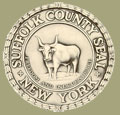|
Back to how to care for your lawn |
For homeowners: Assessing your site 
On Long Island the most popular cool-season lawn grasses include: Kentucky bluegrass, perennial ryegrass, tall fescue and the fine fescues. Most lawn grasses we use in our home lawns require sunlight. In fact, at least 4-6 hours are needed for growth. Some grasses and cultivars can do better in shade and should be used if your site does not have enough sunlight. In some situations a ground cover like Japanese spurge (Pachysandra terminalis) or Myrtle (Vinca minor), to name a few, may be a better choice for your situation. (See also: Deciduous Woody Ground Covers.) In other situations you may want to use a weed suppressive ground cover instead of lawn grasses. More information on weed suppressive (low maintenance) ground covers. If you want a lawn that will require little to no maintenance, consider planting fine fescues. They thrive in acidic, infertile soils and can tolerate shade! Fine fescues grow very slowly and require little to no fertilizer but cannot take much of traffic. If you want your fescue lawn to remain green during dry summers, give it some irrigation. Maintaining a lawn takes time, energy, resources, and money. The first step is to determine the desired maintenance level you are willing to commit to your lawn.
No matter which type of lawn you have, you need to know the size of the area that is being managed. This will be especially important to know when it comes to applying water, pest management materials, or fertilizer. Make a map of your property where you can indicate the areas that receive routine care. You can add up all the areas that are in lawn, for example if your front lawn is 20’ x 30’ (600 square feet) and your back lawn is 50’ x 30’ (1500 square feet) your property has 2100 square feet in lawn. Keep this total in mind when purchasing fertilizer so you don't buy or use more product than needed for the size of your lawn. |
 Suffolk County, N.Y. |
Suffolk County Department of Economic Development and Planning
© Suffolk County |
